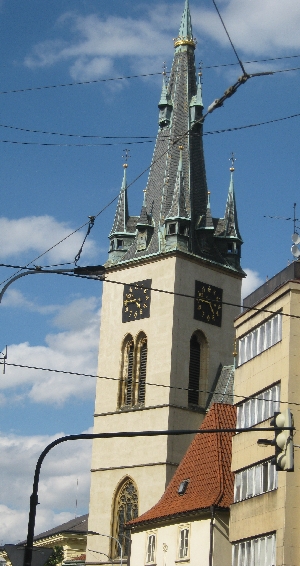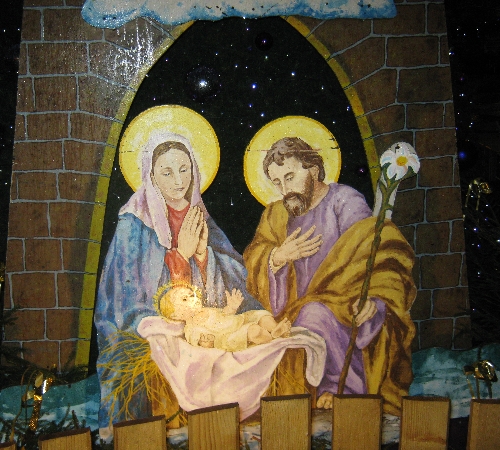
Much as I dislike Christmas being brought forward into the Advent season, working with two expatriate congregations here in the Czech Republic means this inevitably has to happen. So many of our regular worshippers are absent at Christmas because they travel back to their respective home countries in order to spend the holiday season with their family and friends. But before setting off on their travels, many want to be able to participate in the Anglican tradition of a ‘Service of Lessons & Carols’, either in Prague or Brno.
Since commencing regular monthly services in Brno at the beginning of 2012, we have consistently held them on the second Sunday evening of each month. So it seemed right to make the service due on Sunday 9th December, a ‘Service of Lessons & Carols’, a year on from our first ever Brno service in December 2011. And to be further consistent, we held the service in the little Czechoslovak Hussite Church Betanie / Bethany we have been using throughout 2012, rather than returning to the Betlémský Kostel / Bethlehem Chapel where we held the first ever Brno service.
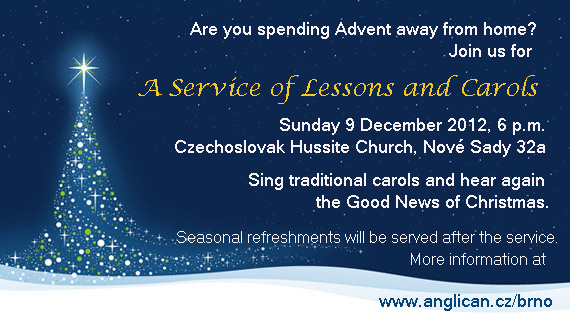
This year’s service was very much a home-grown one, rather than being laid on by members of the Prague congregation. But I was most grateful to my Church Treasurer Gordon Truefitt, who kindly volunteered to travel down with me to Brno following our 11.00 Eucharist in Prague, to give me both company and support. Gordon read a couple of the lessons, sang ‘gold’ in our rendition of ‘We three kings of Orient are’, and as a good treasurer, also took up the collection!
Gordon and I drove down to Brno in my car as I’ve been doing each month since July. Outside of Prague, there was snow on the fields which looked particularly beautiful in the late afternoon sunshine. However, the Prague- Brno motorway itself was completely clear of snow and we reached Brno in very good time. Following the service and some excellent post-service seasonal refreshments kindly laid on by Katka Bánová, Gordon and I returned to the car with light snow falling. But as we left Brno and headed back towards Prague, so the snow got heavier.
Both Prague and Brno lie in river valleys – Prague is on the Vltava River whilst Brno is situated at the confluence of the Svratka and Svitava rivers. But whilst the Vltava flows into the Labe which becomes the Elbe once over the German border, and eventually enters the North Sea, the waters of the Svratka and Svitava head in the opposite direction, eventually entering the Danube which flows out into the Black Sea. Dividing these two major drainage basins are the Vysocina range of hills.
Crossing these hills, the outside temperature dropped from -2° to -6° and the snow got thicker and heavier. Despite the presence of several snow ploughs, one of which nearly tried to clear me from the motorway 🙁 , driving became extremely difficult. Numerous trucks had ground to a halt, unable to cope with climbing up the steeper parts of the motorway. I cannot recall driving in such severe weather conditions for more than thirty years. We did eventually make it back to Prague still in one piece. But a journey that normally takes just over two hours, instead took three and a half hours.
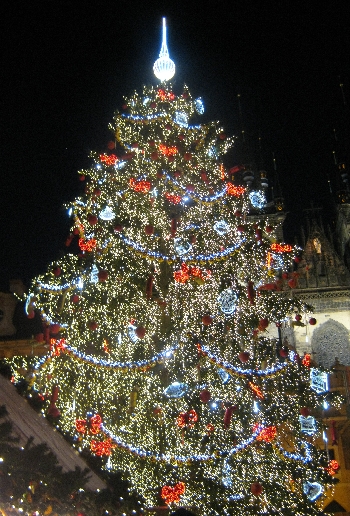
The following weekend, we held our Prague ‘Service of Lessons & Carols’ on the evening of Sunday 16th December. This is the only occasion each year when we hold two services on a Sunday in Prague. Inevitably, some people therefore opt out of the morning Eucharist in order to attend Lessons & Carols in the evening. However, both services were still well supported.
In the evening, we were joined by a small choir from the International Women’s Association of Prague (IWAP). Two of the choir members, Caroline and Celieta, are also regular members of our congregation. But the IWAP choir did give a wonderful lead to our congregational carols as well as contributing two individual choir items. Afterwards, we all enjoyed mulled wine, mince pies and other seasonal refreshments in the Church Hall across the road from the Church in Klimentská 18.
I remarked last year, that Christmas Day falling on a Sunday, as it did in 2011, was ‘Every clergyperson’s delight’. But because of this year being a leap year, Christmas Day in 2012 fell on a Tuesday. This is probably best described as ‘Every clergyperson’s nightmare’ as it meant Church services on three successive days. However, this is where I really benefited from the help and support of others.
On Sunday 23rd December, the Fourth Sunday of Advent, my recently licensed Reader Jack Noonan was the preacher at our 11.00am Eucharist, reflecting on the example and role of Mary, the mother of Jesus. And at our Midnight Eucharist the following day – Christmas Eve, my Presbyterian ministerial colleague Rev’d Dr Karen Moritz was the preacher, giving an exposition of the mystery of the Incarnation as described in John 1. 1-14. So I only had to preach one sermon, on Christmas Day morning, speaking about the message of the angel to the shepherds – ‘to you is born this day in the city of David a Saviour, who is the Messiah, the Lord’.
Whilst having two supportive preachers made my role easier, I did still experience one of those moments for which no training at theological college can ever properly prepare you. At our Midnight Eucharist on Christmas Eve, a British lady, visiting her son who has been living and working in Prague for the past five years, tripped over the chancel step on her way up to receive Communion and fell, seriously banging her head on the stone slabs of the chancel floor.
Fortunately, Sybille as a trained nurse was on hand to help and Honza, Czech husband of American Church Council Secretary Tasci, got on his mobile phone and was promptly able in Czech, to summon an ambulance. But I decided it was best to end the service without singing the final carol, (much to the confusion of the organist who was unaware of what had happened), and within a few minutes, blue lights were flashing outside the Church and two paramedics were striding in.
The good news is that, following a medical examination and an x ray, the lady was given the all clear by a Doctor at a nearby hospital. But she did take home an unusual souvenir from Prague in the form of a large bruise on her forehead 🙁
Our worship on the morning of Christmas Day was thankfully, slightly less eventful. The congregation was a mixture of visitors, long-standing Church members, and several Czech married to English-speaker families with their bilingual children. Therefore, although we are an English-speaking congregation, we did end our worship by singing a carol in Czech, ‘Narodil se Kristus Pán‘ – ‘Christ the Lord is born, let us rejoice’.
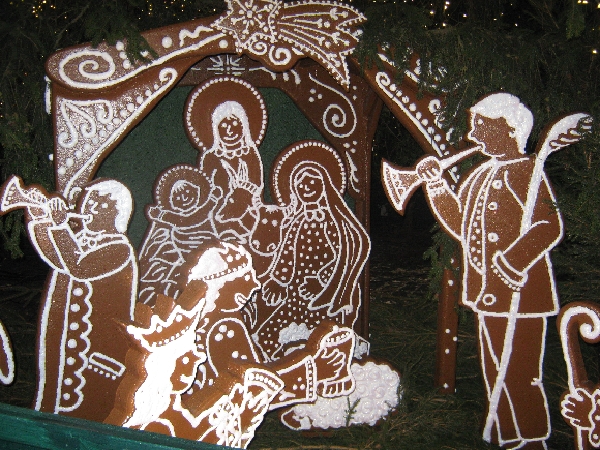

 Further to my
Further to my 